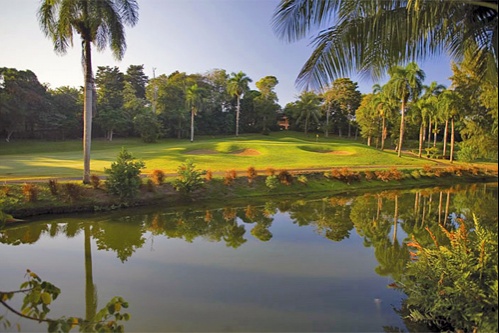 While it’s true that new golf construction starts have slowed to a halt, vintage facilities in need of a haircut and a shave are happily being seated. This is especially true in the Caribbean.
While it’s true that new golf construction starts have slowed to a halt, vintage facilities in need of a haircut and a shave are happily being seated. This is especially true in the Caribbean.
Occupying a coconut and grapefruit plantation an hour’s drive west of San Juan in Puerto Rico, Dorado Beach Resort was the finest golf destination in the islands when it opened in 1958. The original 18-hole course, designed by Robert Trent Jones for Laurance Rockefeller, was carved through a thick tropical forest indented by tidal lagoons. Both the original East and newer West courses at Dorado featured all the master’s trademarks: Runway-style tees, sloping pedestal greens, plenty of sand and water. Plus magnificent views of the steel-blue Atlantic Ocean.
Though treated to a series of well-intentioned makeovers over the years, Dorado Beach eventually lost its flash and filigree. Enter Robert Trent Jones, Jr., who was brought in last fall by KemperSports to oversee a one-year restoration project on the East Course that aims to recapture Jones Sr.’s original design intent while presenting a more flexible and enjoyable course for resort players.
“It’s a treat for me at this point in my career to have the opportunity to refresh some of my father’s most notable work,” said Robert Trent Jones, Jr. “I came to Dorado as a teenager when my father was working here and started to realize how exciting golf course architecture is. It was a formative moment at the very beginning of my career. To come back to this glorious location and revisit my father’s work is especially meaningful.”
The restoration will involve more than mere lather and scissors can deliver. Tees will be adjusted for length and angle. Dense tropical vegetation will be pruned to highlight ocean views, uncover course features and allow more sunlight to nourish the turfgrass. Original green sizes and contours will be reinstated. Bunkers will be restored and repositioned where necessary to accommodate equipment advances. New areas of fairway will permit bump and run shots. Lake edges will be cleaned and reshaped to better define the water hazards. Surface drainage patterns will be revised to enable the course to be played quickly after a rain shower, a common occurrence on Puerto Rico’s north coast.

Dorado Beach epitomizes the tropical golf experience
The East Course will also be stretched so that it can once again host world-class golf events. (In its heyday, Dorado’s East Course hosted 10 Champions Tour events and two World Cups. The resort also attracted Yankees and presidents: Joe DiMaggio, Mickey Mantle, Dwight D. Eisenhower, John F. Kennedy and Gerald Ford all played here in the 1960’s).
One hole on the East Course that may need only minor tweaking is the par-five fourth (formerly the 13th), a Z-shaped double-dogleg that can be safely or heroically but never easily. Long hitters with an appetite for risk must carry the corner of one lake with their drives to set up an approach shot over a second lake to a wide, shallow green. This green is not only elevated and well-bunkered, its rear portion slopes to a sandy beach and the surging sea barely 30 paces away. Safer options abound, but they too are fraught with peril. Towering palm trees, their cement-gray trunks culminating in lush fronds, border the lagoons and can obstruct a clear line to the green.
Singled out by Jack Nicklaus as one of the top 10 holes in the world, Dorado’s piece de resistance is that true rarity, a golf hole that presents a fascinating array of challenges to all types of players. Said Jones Sr. of his pet creation, it “is demanding, but it is fair to all, and it clearly demonstrates the rewards and penalties that should be built into all great holes.”
The East’s fourth hole tends to grab all the attention, but the entire course sparkles. The tricky second hole is a mid-length par three moated by water, while the sixth, a solid par four, has enough fruit-bearing trees in the rain forest up its left side to consider stopping for lunch. The finish is classic: a sturdy 440-yard par-four that bends to the left and plays to a large, well-defended green set below the oceanfront clubhouse. Always swept by sea breezes, the East’s 18th is fitting finale to a course that should reclaim its title as the No. 1 track in Puerto Rico when Jones Jr. and his design team complete their work later this year.
